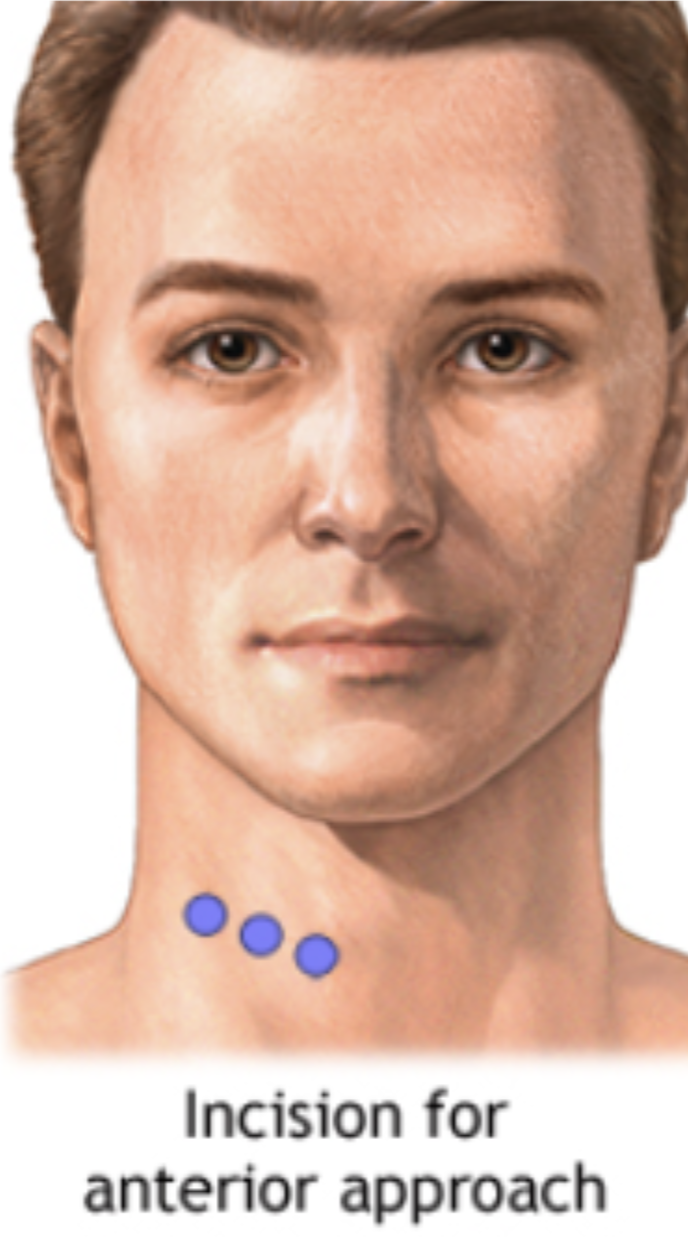ACDF (Anterior Cervical Discectomy and Fusion) surgery typically results in a scar on the front of the neck; however, in most cases, the scar is barely noticeable after it heals. Dr. Lanman makes the smallest, cleanest incision he needs to perform ACDF. He also closes the incision with the utmost care, which helps minimize the appearance of the ACDF surgery scar. In this article, we discuss the ACDF procedure and how to get the least noticeable ACDF surgery scar possible.
How big is the scar from ACDF surgery?
If you have one level ACDF surgery, the ACDF surgical scar is about 1 to 1.5 inches long. For example, in one study comparing the aesthetic results of suturing to stapling the skin after ACDF surgery, the average ACDF surgery scar length was 46.44 ± 12.16 mm for sutures and 45.97 ± 12.77 mm for staples. If you are having ACDF surgery at more than one level than you may need a longer incision or more than one incision. In general, multiple small incisions provide a better cosmetic result, but be sure to discuss your options with Dr. Lanman.
What does a scar look like after neck surgery?
Scar Appearance
The most common scar appearance after ACDF is barely noticeable line. Soon after ACDF surgery, the line will be darker than the surrounding skin. However, when it is fully healed, it will usually be slightly lighter than the surrounding skin or simply a shallow trough where the incision was made. For people prone to keloids, the edges of the scar could look different. If you are prone to developing keloids or hypertrophic scars, talk to Dr. Lanman about your options before ACDF surgery.
How do you care for an ACDF incision?
Keep the incision clean and dry. Several days after surgery, you can generally start showering, but avoid baths, hot tubs, and swimming pools for 3 weeks to reduce the risk of infection. When showering, gently clean the incision with mild soap and water, but do not scrub it. Pat the area dry with a towel.
Contact Dr. Lanman if you experience increasing redness, swelling, drainage, fever, or other signs of infection around the incision.
Scar Management
Several factors influence scar healing. Some are within your control and others are not. Age, circulating hormones, and even gender can influence the rate and overall success of ACDF scar healing. People who are immunocompromised, e.g., those with HIV/AIDS, cancer, people take immunosuppressants, will take longer to heal. Obesity, heavy alcohol use and smoking can interfere with healing. On the other hand, getting adequate nutrients and minerals can accelerate healing and reduce scar formation.

Where is the incision for ACDF?
The incision for ACDF is on the front of the neck (the A in ACDF stands for anterior).
Post-Operative Recovery
Unless you have one or more risk factors that would require hospitalization, ACDF is now a “same day” surgery. That means you come to the surgery center in the morning and leave later in the day. Of course, you will be observed during the postoperative period to ensure that it is safe for you to leave. It is normal to be a little hoarse and have mild discomfort when swallowing; however, breathing issues, severe, pain, and substantial difficulty swallowing are abnormal and will be treated.
If there is no drainage, the incision can be left open to air after 3 days. If there is drainage, cover it with a clean, dry dressing. Initially, you should avoid using any ointments or creams on the incision. However, once the incision is healed, apply sunscreen over it when going outside. The healed skin is extremely prone to sun damage.
Short-Term and Long-Term Restrictions After ACDF Surgery
As you heal, you will not be able to do certain things for certain periods of time. This is to ensure that your body heals as quickly and healthfully as possible.
Short-Term Restrictions (First ~6 Weeks)
Avoid heavy lifting, typically more than 5kg (11lbs)
Limit neck movements like sharp head turns, bending over, and twisting
Avoid strenuous activities like yard work, heavy cleaning, and contact sports
Wear a neck brace or collar as directed, usually for 6-12 weeks for multilevel ACDF. Dr. Lanman usually does not use bracing.
Restrict driving until Dr. Lamna clears you to drive, usually 1-6 weeks
Avoid baths, swimming, and hot tubs until the incision is fully healed, usually 3 weeks
Long-Term Restrictions
You can usually return to most activities once the fusion has fully healed
Avoid prolonged neck flexion, such as excessive smartphone/tablet use
Avoid strenuous activities that stress the spine like gymnastics and contact sports
Keep in mind that patients permanently lose 5-10% of forward neck bending flexibility per fused level
There is also a 10-15% Increased risk of needing additional neck surgery on adjacent segments within 10-15 years after ACDF
Other Considerations
Rehabilitation and Physical Therapy
Physical therapy is often recommended for 2-3 months after ACDF surgery to help regain strength and range of motion. The main goals of physical therapy after ACDF are to improve range of motion in the neck and strengthen postural flexibility and stability.
Potential Complications
The complication rate of ACDF is quite low, but complications could occur that affect healing and recovery.
Uncommon complications, not usually serious
Difficulty swallowing (dysphagia) – This is the most common complication, occurring in 1.7-9.5% of cases. It is usually temporary but can be persistent in rare cases.
Bleeding and hematoma formation
Nerve damage – This can lead to pain, weakness, numbness, or paralysis in the arms or legs. The risk is around 1 in 10,000 cases.
Respiratory insufficiency
Failure of the bone graft to heal properly (pseudarthrosis)
Adjacent segment disease (ASD) – Degeneration of the discs above or below the fused segment
Rare complications, but serious
Spinal cord damage (about 1 in 10,000 cases)
Damage to the trachea or esophagus
Hematoma or seroma causing airway compromise
Horner’s syndrome (ptosis, miosis, anhidrosis) due to damage to the sympathetic trunk (0.06%-1.1% risk)
Bilateral phrenic nerve injuries leading to respiratory insufficiency
Internal jugular venous thrombosis
Final Thoughts from Dr. Lanman
ACDF (Anterior Cervical Discectomy and Fusion) surgery typically results in a scar on the front of the neck, but in most cases, it is barely noticeable after healing. Keeping your body healthy and following discharge instructions allows the scar to heal as quickly as possible. The skill of your surgeon also affects the ACDF surgery scar, so seek out a professional who takes the care needed to minimize scar formation. Dr. Lanman has decades of experience in ACDF and artificial disc replacement. Contact Dr. Lanman’s office today to schedule a consultation.
FAQS:
When is it too late to massage scar tissue after surgery?
Scar massage should not be started until the skin has fully healed, usually 4 weeks after surgery. There is never really a time that it is too late to massage scar tissue after ACDF surgery, only too early. As long as the incision has fully healed, scar massage can be beneficial even months or years after the initial surgery to help keep the tissue around the scar loose and prevent it from adhering to the underlying tissues
How do you sleep after cervical neck surgery?
Sleeping on your back or sides are the best positions to protect your neck and spine after surgery. Likewise, avoid sleeping on your stomach, if possible. Keep your head, neck, and hips aligned when lying on your back or side. If you sleep on your side, use a firm pillow and place another pillow between your legs to support your back. Lastly, get into and out of bed carefully. For those who are interested, you can read a detailed description of how to sleep after cervical disc replacement surgery.
What are the permanent restrictions after ACDF surgery?
There are no permanent restrictions on most activities after ACDF surgery. You will lose some neck mobility after surgery, which could impact performance. Most people should avoid high impact activities to protect their neck, but ask Dr. Lanman if this is a concern. Also, if you want to learn more, check out our article on restrictions after cervical disc replacement.
How long does it take for muscles to heal after ACDF surgery?
Unlike posterior spine surgery, anterior spine surgery including ACDF does not disrupt the muscles. Therefore, there is usually minimal post-operative muscle pain. That said, patients may feel discomfort for 1 to 4 weeks after ACDF as the incision and spine heal.
How long do you have to wear a brace after ACDF surgery?
You may not need to wear a brace at all, especially if you only have ACDF at one level. In multilevel ACDF, you may need to wear a brace for 6 to 12 weeks. Dr. Lanman does not usually use bracing.







